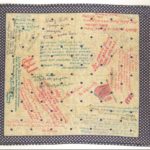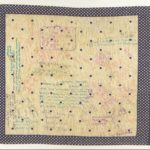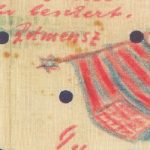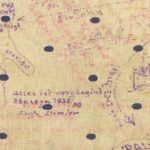WWII Handkerchief
- What can we see?
We can see many black dots and hand-written messages. We can also see an American flag drawing.
Look again, what can you see?
- What do we know?
This handkerchief is one of two given to Lotte Frankel by a Polish Relief organisation whilst she was in Zbaszyn refugee camp in Poland. Lotte stayed in the camp for seven months before coming to Britain on a student permit. The handkerchiefs were signed by her fellow inmates before she left. Lotte’s parents were sent to the Lodz ghetto and her mother was later deported to Auschwitz where she was murdered.
The Zbaszyn refugee camp was a temporary settlement built for Jews of Polish nationality who were expelled from Germany. Following the conquest by Nazi Germany and the USSR in 1939, the country’s most fertile agricultural land was devoted to Germany. The Jewish refugees were stranded on the border, and denied admission to Poland after their expulsion from Germany.
The remaining area of occupied-Germany did not produce enough food to feed its population, and was not providing adequate service and very soon started to exclude Jews from its official aid programmes. Therefore, Herbert Hoover (the former US president) and the Polish government in exile organised the Polish Relief in September 1939 to aid the refugees with food and clothes.
- What do we wonder?
We might wonder what is life like inside the refugee camp? We might wonder what the relationship between Lotte and her fellow inmates was like? We might also wonder what happened to the other handkerchief owned by Lotte?
What do you wonder?
- Object File
Name: Handkerchief
Date: 1938-1939
Object No: 2000.5.1
Material: Cotton
Size (cm): 37 x 42.5 cm
Created by: Unknown
In 1933 Adolf Hitler and the Nazi political party came to power in Germany. Hitler and the Nazis had firm views on race. They believed that all ‘other’ groups were inferior to the Aryans (people with blue eyes and blonde hair), and that they would ruin the purity of the superior “Master Race”. Both Jews and Poles in areas of Nazi Germany occupied was considered by German authorities to be “sub-human” and, as such, targeted for extermination.
Jews were persecuted most heavily under the Nazi regime. From 1933 onwards there was gradual persecution of the Jews, including forced sterilisation, medical experimentation, incarceration, brutality and murder. It reached a turning point during Kristallnacht in November 1938 as the Nazis organised a violent attack against the Jewish community nationwide. After that, the British government allowed more people from the German-occupied areas to move to Britain by having obtained employment or a guarantor, via the Kindertransport. There were about 70,000 Jewish refugees who were accepted in Britain by the start of World War II in September 1939, and an additional 10,000 people who made it to Britain during the war.
–
This object file has been written and published by Learning Intern, Yutzu.




